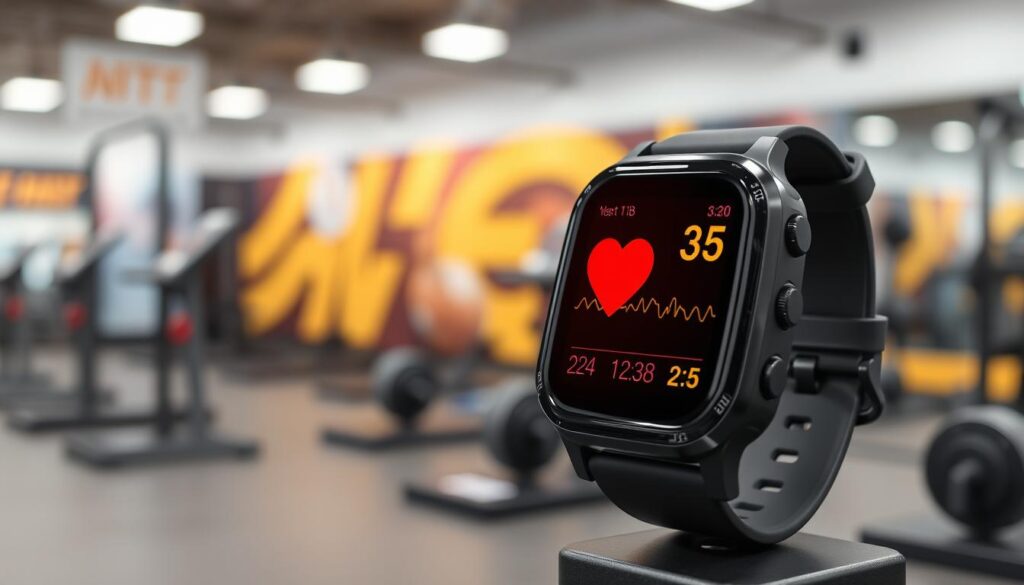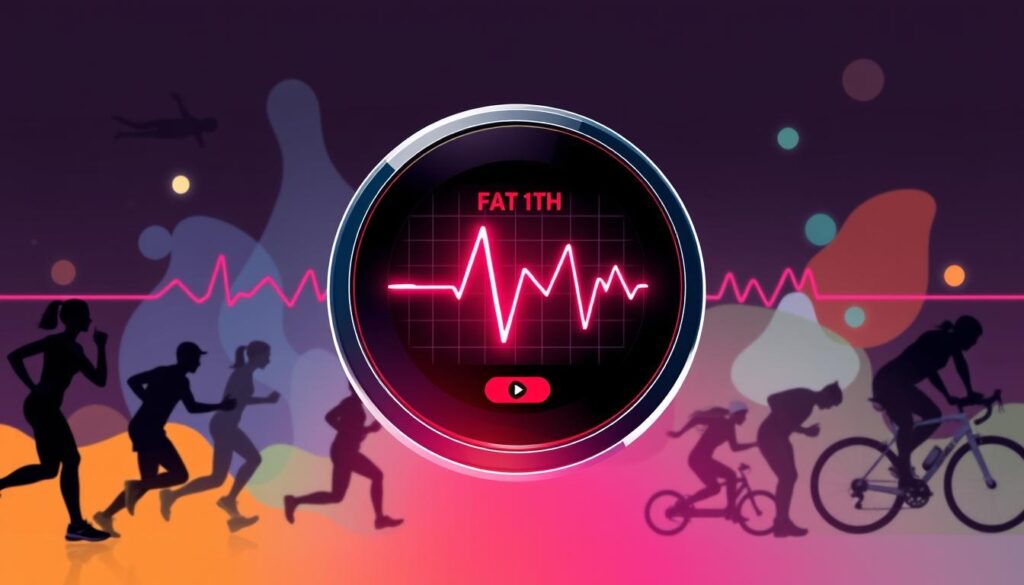Finding your fat-burning heart rate is key to losing weight. It’s usually between 70-80% of your top heart rate. This number changes based on how old you are and if you’re a man or woman.
When you work out in this zone for 30 minutes, you burn fat instead of carbs. This helps you lose weight and get fitter.
Key Takeaways
- Your fat-burning heart rate is typically 70-80% of your maximum heart rate.
- Exercising in the fat-burning zone helps your body use stored fat for energy.
- Achieving your target fat-burning heart rate can significantly impact your weight loss journey.
- Understanding your fat-burning heart rate is crucial for effective cardio workouts.
- Monitoring your heart rate during exercise can help you maximize calorie and fat burn.
Understanding Fat-Burning Heart Rate Basics
Reaching your fitness goals means knowing about the “fat-burning zone.” This is when your body uses fat for energy more than carbs. Training in this zone helps you lose fat and get healthier.
What Happens When You Hit the Fat-Burning Zone
When your heart rate is between 64-76% of your max, you’re in the fat-burning zone. Your body starts using fat for energy instead of carbs. This makes you burn fat more efficiently.
The Science Behind Fat Burning
Exercise at a moderate pace makes your body use fat for energy. This is different from high-intensity workouts that use carbs. Training like this helps you manage weight better over time.
Benefits of Training in the Fat-Burning Zone
- Improved cardiovascular health
- Increased endurance and stamina
- More efficient fat metabolism
- Contribution to long-term weight management
- Overall fitness improvements
Working out in the fat-burning zone has many benefits. It helps you reach your fitness goals and stay healthy. Knowing about this zone makes your workouts more effective.
“The fat-burning zone is a powerful tool for those seeking to lose weight and improve their health. By training in this targeted heart rate range, you can unlock the body’s natural fat-burning potential.”
How to Calculate Your Fat Burn Heart Rate Target
To start burning fat, you need to know your target heart rate. First, find your maximum heart rate. You can do this by subtracting your age from 220. For instance, if you’re 35, your maximum heart rate is 185 beats per minute (bpm).
After finding your maximum heart rate, you can figure out your fat-burning zone. This zone is between 60-80% of your maximum heart rate. To find it, multiply your maximum heart rate by 0.6 and 0.8. So, for a 35-year-old, the zone is 111-148 bpm.
Remember, these numbers are just estimates. Your fitness level and other factors can change your best heart rate for burning fat. It’s smart to talk to a fitness expert or use a heart rate monitor to get your exact target heart rate for more calorie burn and fat loss.
“The fat-burning zone typically corresponds to 60-80% of the maximum heart rate, ensuring optimal fat burning during exercise.”
Learning how to find your fat-burning heart rate target helps you train better. You’ll see better results in losing weight and getting fit.
The Connection Between Heart Rate and Fat Loss
Your heart rate is key for losing weight. It shows how hard you’re working out. Harder workouts burn more calories and fat.
Why Heart Rate Matters for Weight Loss
Keeping your heart rate between 60-80% of its max is good for losing fat. This helps your body use fat for energy more. It burns fat faster than using carbs.
Optimal Duration in the Fat-Burning Zone
For best fat-burning, work out for 30 minutes in your target zone. Longer, like 45-60 minutes, burns even more fat. But, don’t overdo it to avoid getting too tired.
“Maintaining your heart rate in the optimal fat-burning zone can significantly boost your weight loss efforts.”
Different Heart Rate Zones Explained
Knowing about heart rate zones is key to better training and fitness goals. Each zone has its own role and benefits.
The resting heart rate zone is between 60-100 beats per minute (bpm). The moderate-intensity zone is 50-70% of your max heart rate. The fat-burning zone is 70-80% of your max, great for losing weight.
Going up in intensity, you hit the aerobic zone (70-80% of max) and anaerobic zone (80-90% of max). These zones boost your heart health and performance. The maximum heart rate zone (100% of max) pushes you to your limits.
Knowing these zones helps you set up workouts for your goals. Whether it’s losing weight, getting better at endurance, or improving heart health. Finding the right mix of zones is crucial for effective training.
“Consistent training within the fat-burning zone can lead to significant long-term weight loss and improved overall fitness.”
Your heart rate zones can change based on age, fitness, and resting heart rate. By watching your heart rate and staying in the right zones, you get the most from your workouts. This helps you reach your fitness goals.
Age-Specific Fat-Burning Heart Rate Charts
Finding the right heart rate for burning fat is key for losing weight and staying fit. But, this rate changes a lot with age. Knowing these age-specific guidelines helps you tailor your workouts for better fat burning.
Understanding Your Target Numbers
As you age, your heart rate for burning fat goes down. For example, a 20-year-old might aim for 128-152 beats per minute. But, a 50-year-old might aim for 109-129 bpm. These numbers are a good start, but you should adjust them based on how fit you are.
Adjusting Targets Based on Fitness Level
- Start at the lower end of your age’s fat-burning zone if you’re new to exercise.
- If you’re more experienced, aim for the higher end to keep challenging yourself.
- Check and adjust your heart rate often to keep making progress and avoid hitting a wall.
Knowing your age’s fat-burning heart rate and adjusting it for your fitness level helps you make a workout plan that suits you. This plan can help you reach your weight loss and health goals.
| Age | Fat-Burning Heart Rate (bpm) |
|---|---|
| 20 | 128-152 |
| 30 | 118-141 |
| 40 | 109-131 |
| 50 | 109-129 |
| 60 | 100-120 |
Keep in mind, these are just guidelines. Your fitness level, how active you are, and other things can change your best heart rate for burning fat. The best way to make sure you’re in the right zone is to watch your heart rate and adjust your workout as needed.
Best Tools to Monitor Your Heart Rate
It’s important to watch your heart rate to get better at fitness and burn fat. There are many tools to help you do this easily.
Wrist-worn heart rate monitors are easy to use every day. They track steps, calories, and sleep. This gives you a full picture of your health.
Chest strap monitors are more accurate for hard workouts. They go around your chest to measure heart rate. This is great for intense cardio to keep you in the right zone.
Smartphone apps are also good. They turn your phone into a heart rate monitor. You can track your heart rate anywhere, making it easy to see how you’re doing.
| Product | Price Range | Battery Life | Key Features |
|---|---|---|---|
| Fitbit Versa 4 | $$ | 6+ days | Heart rate, breathing rate, steps, distance, calories, sleep, stress |
| Garmin HRM-Pro | $$ | 1 year | Heart rate, cadence, vertical oscillation, ground contact time |
| Apple Watch | $$$ | 18+ hours | Heart rate, ECG, blood oxygen, workout tracking |
When picking a heart rate monitor, think about price, battery life, and what you want to track. The right tool will help you improve your cardio and burn fat.

Effective Workouts for Fat-Burning Success
To burn fat well, mix low and moderate exercises in your week. These workouts hit the fat-burning zone and boost fitness and heart health.
Low-Intensity Exercise Options
For beginners or those recovering, low-intensity exercises are perfect. Try brisk walking, swimming, or cycling at under 10 mph. These activities help burn fat gently and fit easily into your day.
Moderate-Intensity Activities
When you get more fit, try moderate exercises to push yourself harder. Jogging, tennis, and aerobic dancing raise your heart rate well for fat loss. They need more effort but help lose weight and boost cardio intensity.
Balance low and moderate exercises in your week. This mix boosts fat burning, fitness, and health.
“Consistency is key when it comes to achieving your fat-burning goals. Incorporate a variety of low and moderate-intensity exercises to keep your body challenged and engaged.”
Common Mistakes When Training in Fat-Burning Zone
Many people focus too much on the “fat-burning zone” for weight loss. But, there are mistakes to avoid. Let’s look at some common errors to stay away from.
- Exercising at Too High an Intensity: The fat-burning zone is between 50% to 72% of your max heart rate. Going too hard can make your body burn carbs more than fat.
- Not Exercising Long Enough: You need to work out for at least 30 minutes in the fat-burning zone. Shorter times might not help you burn enough fat.
- Relying Solely on the Fat-Burning Zone: While it’s important, don’t just focus on the fat-burning zone. Mix in different cardio intensity and weight loss exercise for a better fitness plan.
The fat-burning zone is just part of the weight loss puzzle. A balanced plan with good food, strength training, and varied cardio intensity is best for reaching your goals.

| Intensity Level | Heart Rate Range (% of MHR) | Primary Fuel Source |
|---|---|---|
| Low Intensity | 50-70% | Fat |
| Moderate Intensity | 70-80% | Carbohydrates |
| High Intensity | 80-90% | Carbohydrates |
| Maximum Intensity | 90-100% | Carbohydrates |
Knowing these mistakes and adjusting your workout can help you get the most out of the fat-burning zone. This way, you can reach your weight loss goals better.
Factors Affecting Your Fat-Burning Heart Rate
Many things can change how well you burn fat. Eating right and drinking water help a lot. They keep your energy up and your heart rate steady.
Getting enough sleep is also key. Too much exercise can mess up your body’s rhythm. This makes it hard to stay in the fat-burning zone.
Impact of Diet and Hydration
What you eat before working out matters a lot. Eating foods full of complex carbs, lean proteins, and healthy fats gives you energy. It helps you stay in the fat-burning zone.
Drinking enough water is also important. It keeps your heart rate steady. This stops it from going too high too fast.
Role of Rest and Recovery
Rest and recovery are just as important. Too much exercise can raise stress hormones. This hurts your weight loss exercise and cardio intensity.
Getting enough sleep and managing stress helps. It keeps your results steady in the fat-burning zone.
Other things like medicines and health can also change your heart rate. A complete plan that looks at diet, hydration, rest, and your body is best. It helps you burn fat better.
“Reaching your fat-burning heart rate is a delicate balance that requires attention to various lifestyle factors. With the right combination of nutrition, hydration, and recovery, you can unlock the full benefits of training in the fat-burning zone.”
Combining Heart Rate Training with Nutrition
Heart rate training and good nutrition are key for lasting weight loss and fat loss. Knowing your fat-burning heart rate helps. It lets you match your workouts with a diet that’s right for you. This way, you can get better results and hit your fitness goals faster.
Eat foods that are full of nutrients. Choose lean proteins, healthy fats, and complex carbs for your meals. Eat the right amount and drink lots of water to help with your cardio intensity workouts. Eating at the right time can also boost your energy and help you recover.
- Try to eat fewer calories by eating less and exercising more for lasting fat loss.
- Add strength training to build muscle. This raises your metabolism, helping you burn more calories all day.
- Make sure you get enough protein to keep your muscles strong. This helps with your weight loss exercise too.
It’s all about finding a balance between what you eat and how you exercise. This balance is the secret to burning fat well. By combining these two important parts, you’re on your way to lasting health and fitness success.
“The secret to sustained fat loss lies in the perfect harmony between your exercise routine and your nutritional choices.”
Advanced Strategies for Optimizing Fat Burn
Try high-intensity interval training (HIIT) to boost your fat burning. HIIT makes your metabolism work harder. It keeps burning fat even when you’re not working out.
HIIT mixes intense effort with rest. This keeps your body guessing and stops you from getting stuck.
Varying your workout intensity is also key. Don’t always stay in the same heart rate zone. Try different zones to keep your body challenged.
Training in different zones prevents your body from getting too used to one thing. This helps you keep losing weight.
Keep checking and changing your target heart rates as you get fitter. What worked before might not now. Adjusting your heart rate helps you keep burning fat.


A Life-Changing Experience with This Weight Loss Supplement (Nagano Tonic)
I’ve always struggled with finding a weight loss solution that actually works for me. Like many, I’ve tried numerous diets, exercise routines, and supplements over the years—some worked for a short time, but nothing ever gave me long-term results. That was until I decided to try the weight loss supplement I found : Link to the Supplement.
From the moment I started using it, I noticed a difference. Not only did I feel more energized, but my cravings also became more manageable. The best part? I started seeing results much quicker than I anticipated! Over the course of just a few weeks, I noticed a significant reduction in belly fat and overall weight loss that I hadn’t been able to achieve before.
What makes this supplement stand out from all the others I’ve tried is how it supports me in my daily routine without any jitters or energy crashes. I’m able to stay focused and motivated, which has made it easier to stay on track with my diet and exercise plan.
This product truly exceeded my expectations, and I feel more confident and healthier than ever before. If you’re struggling with your weight loss journey like I was, I highly recommend giving this supplement a try. It’s been a game-changer for me, and I’m sure it can work wonders for you too!
Contant Them on email .. tonicnagano50@gmail.com
I’ve tried so many weight loss products over the years, but nothing worked like this supplement! Since I started using it, I’ve noticed a big difference in my energy levels and appetite control. In just a few weeks, I’ve lost weight and feel so much better. It’s been easy to stick with, and the results speak for themselves. Highly recommend this to anyone looking to make a real change!
wasn’t sure what to expect, but this weight loss supplement has really impressed me! After just a few weeks of use, I’ve already dropped a few pounds and feel more motivated to stay active. It’s helped curb my cravings and boosted my energy throughout the day. I’m excited to keep going and see even better results. Definitely worth trying!
Reach them on tonicnagano50@gmail.com
I was skeptical at first, but this supplement has truly made a difference in my weight loss journey. I’ve lost weight without feeling deprived or sluggish. My cravings are under control, and I feel more confident in my body. It’s easy to incorporate into my daily routine, and the results speak for themselves. I’m so glad I gave it a try!
Thanks David, i do use the link to make my purchase. you can get too here http://surl.li/iasppy
I’ve tried so many weight loss products, but this one has been by far the most effective. In just a few weeks, I’ve noticed a visible difference in my body and energy levels. It’s helped me stay on track without the constant hunger pangs and cravings. I’m really happy with my progress and can’t wait to see where I’ll be in another month!
This Nagano Tonic has been amazing! In just a few weeks, I’ve lost weight, feel more energized, and my cravings are under control. Highly recommend it!
Thats the link to purchase http://surl.li/iasppy